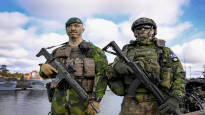Sweden’s long wait for NATO membership ended today, Monday, when the Hungarian parliament approved the country’s membership.
Sweden becomes the 32nd member of the military alliance.
Like Finland, our western neighbor is welcome to join NATO, and that will strengthen the alliance’s defense, especially in the Nordic region.
But how do the defense forces of Sweden and Finland differ from each other?
We compiled the most important figures into graphics.
The first of them shows the personnel differences between the defense forces.
Military strategy teacher at the Swedish National Defense University Joakim Paasikivi confirms what can already be concluded from the graphic above:
Finland’s defense forces and, above all, land forces are significantly larger than Sweden’s.
– Both countries are technologically very advanced. The most important difference is related to the fact that Finland has not cut the rate, says Paasikivi.
Unlike in Sweden and many other Western European countries, Finland’s armed forces were not significantly reduced after the collapse of the Soviet Union.
This can be seen both in the amount of equipment and personnel.
While there are 870,000 reservists in Finland, the strength of the home security forces corresponding to reservists in Sweden is only tens of thousands. The strength of Finland’s wartime forces is still many times higher than Sweden’s.
The difference in size is explained by the fact that the Finnish Defense Forces have always relied on general conscription. In Sweden, general conscription was long gone, and compulsory conscription still does not affect as large a part of the age group as in Finland.
The differences in equipment become apparent when you look at the ground forces and especially the artillery.
Finland has a huge number of cannons and heavy mortars, by European standards, more than 1,600. The Swedish Defense Forces did not tell the exact number of artillery, but according to various open sources, there are several hundred of them. Used in graphics armedforces.eu website estimate.
In the graphic below, you can view some of the equipment differences between the defense forces.
According to Paasikivi, Sweden’s strengths lie in its own high-quality military technology.
Paasikivi mentions, for example, submarines, which are a special sector of the Swedish defense industry.
There are no submarines in Finland at all.
In addition, Sweden manufactures Gripen E fighters, which Paasikivi describes as excellent. However, the technological advance brought by them will be closed when the F 35 fighters that Finland acquired from the United States arrive.
According to Paasikivi, the quality differences between Finland and Sweden are largely small, and he emphasizes that the quality is high on both sides.
– What we have is good, but it is too little, Paasikivi summarizes Sweden’s situation.
Defense budgets are growing rapidly
Both Finland and Sweden have increased their defense budgets rapidly in recent years, and they have reached the goal set by NATO.
According to the goal, the member states must spend at least two percent of the gross national product on defense spending.
Especially in Sweden, the increase in spending has been huge in recent years. The budget has almost doubled since 2020.
See below how much money Finland and Sweden have spent on military spending.
However, a larger defense budget does not immediately increase the capabilities of the Swedish Defense Forces significantly.
– At this moment, war supplies are expensive and prices are rising, which makes it difficult to increase the amount of equipment. Training the troops also takes a lot of time, Paasikivi explains.
Is Finland, despite the smaller budget, still militarily stronger than Sweden?
– Yes, it is. It is quite difficult to use it to dispute, Paasikivi answers.
He justifies his position first of all with the larger number of Finnish equipment and troops.
– Quantity also means ability.
Paasikivi points out, however, that more important than the comparison between Finland and Sweden is the cooperation between the countries, and the benefits it brings.
One of the benefits is geographical. As a result of Sweden’s membership, all Baltic Sea countries except Russia belong to NATO.
– Thanks to that, we can help the fleets of Finland and other Baltic Sea countries to secure shipping in the Baltic Sea. In addition, Sweden could act as a sort of logistics base for the north, says Paasikivi.
This is a great benefit for Finland’s security of supply as well.
In addition, the entire Nordic region benefits from Sweden’s special military technical know-how, Paasikivi states. Joint planning and coordination of Pohjola’s defense will also become easier with membership.
See below how the commander of the Vaasa coastal battalion, Atte Löytönen, commented on the joint work of the Swedish and Finnish forces last April.
